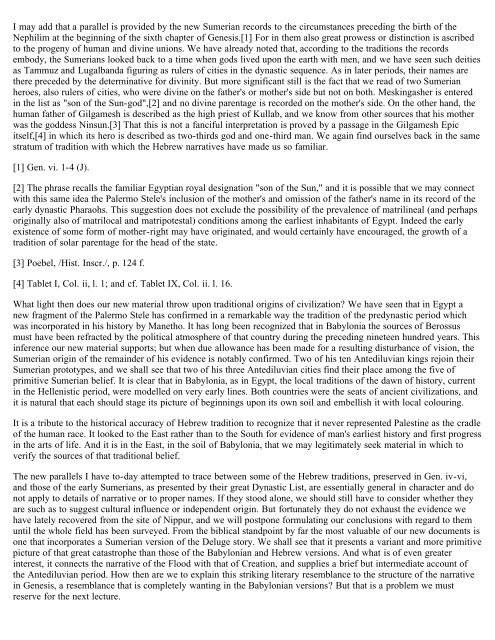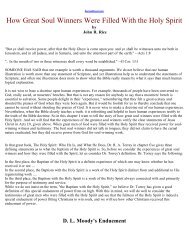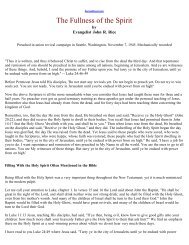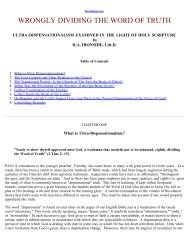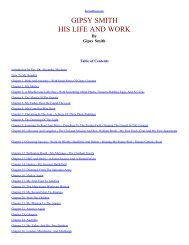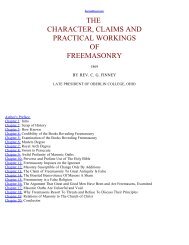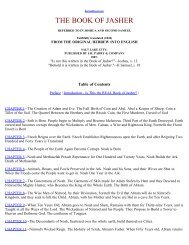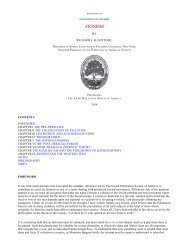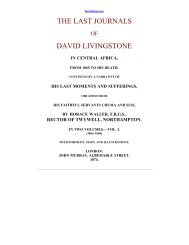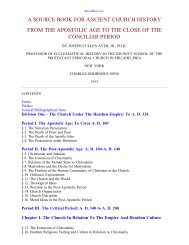Legends of Babylon and Egypt in Relation to Hebrew Tradition.pdf
Legends of Babylon and Egypt in Relation to Hebrew Tradition.pdf
Legends of Babylon and Egypt in Relation to Hebrew Tradition.pdf
Create successful ePaper yourself
Turn your PDF publications into a flip-book with our unique Google optimized e-Paper software.
I may add that a parallel is provided by the new Sumerian records <strong>to</strong> the circumstances preced<strong>in</strong>g the birth <strong>of</strong> the<br />
Nephilim at the beg<strong>in</strong>n<strong>in</strong>g <strong>of</strong> the sixth chapter <strong>of</strong> Genesis.[1] For <strong>in</strong> them also great prowess or dist<strong>in</strong>ction is ascribed<br />
<strong>to</strong> the progeny <strong>of</strong> human <strong>and</strong> div<strong>in</strong>e unions. We have already noted that, accord<strong>in</strong>g <strong>to</strong> the traditions the records<br />
embody, the Sumerians looked back <strong>to</strong> a time when gods lived upon the earth with men, <strong>and</strong> we have seen such deities<br />
as Tammuz <strong>and</strong> Lugalb<strong>and</strong>a figur<strong>in</strong>g as rulers <strong>of</strong> cities <strong>in</strong> the dynastic sequence. As <strong>in</strong> later periods, their names are<br />
there preceded by the determ<strong>in</strong>ative for div<strong>in</strong>ity. But more significant still is the fact that we read <strong>of</strong> two Sumerian<br />
heroes, also rulers <strong>of</strong> cities, who were div<strong>in</strong>e on the father's or mother's side but not on both. Mesk<strong>in</strong>gasher is entered<br />
<strong>in</strong> the list as "son <strong>of</strong> the Sun-god",[2] <strong>and</strong> no div<strong>in</strong>e parentage is recorded on the mother's side. On the other h<strong>and</strong>, the<br />
human father <strong>of</strong> Gilgamesh is described as the high priest <strong>of</strong> Kullab, <strong>and</strong> we know from other sources that his mother<br />
was the goddess N<strong>in</strong>sun.[3] That this is not a fanciful <strong>in</strong>terpretation is proved by a passage <strong>in</strong> the Gilgamesh Epic<br />
itself,[4] <strong>in</strong> which its hero is described as two-thirds god <strong>and</strong> one-third man. We aga<strong>in</strong> f<strong>in</strong>d ourselves back <strong>in</strong> the same<br />
stratum <strong>of</strong> tradition with which the <strong>Hebrew</strong> narratives have made us so familiar.<br />
[1] Gen. vi. 1-4 (J).<br />
[2] The phrase recalls the familiar <strong>Egypt</strong>ian royal designation "son <strong>of</strong> the Sun," <strong>and</strong> it is possible that we may connect<br />
with this same idea the Palermo Stele's <strong>in</strong>clusion <strong>of</strong> the mother's <strong>and</strong> omission <strong>of</strong> the father's name <strong>in</strong> its record <strong>of</strong> the<br />
early dynastic Pharaohs. This suggestion does not exclude the possibility <strong>of</strong> the prevalence <strong>of</strong> matril<strong>in</strong>eal (<strong>and</strong> perhaps<br />
orig<strong>in</strong>ally also <strong>of</strong> matrilocal <strong>and</strong> matripotestal) conditions among the earliest <strong>in</strong>habitants <strong>of</strong> <strong>Egypt</strong>. Indeed the early<br />
existence <strong>of</strong> some form <strong>of</strong> mother-right may have orig<strong>in</strong>ated, <strong>and</strong> would certa<strong>in</strong>ly have encouraged, the growth <strong>of</strong> a<br />
tradition <strong>of</strong> solar parentage for the head <strong>of</strong> the state.<br />
[3] Poebel, /Hist. Inscr./, p. 124 f.<br />
[4] Tablet I, Col. ii, l. 1; <strong>and</strong> cf. Tablet IX, Col. ii. l. 16.<br />
What light then does our new material throw upon traditional orig<strong>in</strong>s <strong>of</strong> civilization? We have seen that <strong>in</strong> <strong>Egypt</strong> a<br />
new fragment <strong>of</strong> the Palermo Stele has confirmed <strong>in</strong> a remarkable way the tradition <strong>of</strong> the predynastic period which<br />
was <strong>in</strong>corporated <strong>in</strong> his his<strong>to</strong>ry by Manetho. It has long been recognized that <strong>in</strong> <strong>Babylon</strong>ia the sources <strong>of</strong> Berossus<br />
must have been refracted by the political atmosphere <strong>of</strong> that country dur<strong>in</strong>g the preced<strong>in</strong>g n<strong>in</strong>eteen hundred years. This<br />
<strong>in</strong>ference our new material supports; but when due allowance has been made for a result<strong>in</strong>g disturbance <strong>of</strong> vision, the<br />
Sumerian orig<strong>in</strong> <strong>of</strong> the rema<strong>in</strong>der <strong>of</strong> his evidence is notably confirmed. Two <strong>of</strong> his ten Antediluvian k<strong>in</strong>gs rejo<strong>in</strong> their<br />
Sumerian pro<strong>to</strong>types, <strong>and</strong> we shall see that two <strong>of</strong> his three Antediluvian cities f<strong>in</strong>d their place among the five <strong>of</strong><br />
primitive Sumerian belief. It is clear that <strong>in</strong> <strong>Babylon</strong>ia, as <strong>in</strong> <strong>Egypt</strong>, the local traditions <strong>of</strong> the dawn <strong>of</strong> his<strong>to</strong>ry, current<br />
<strong>in</strong> the Hellenistic period, were modelled on very early l<strong>in</strong>es. Both countries were the seats <strong>of</strong> ancient civilizations, <strong>and</strong><br />
it is natural that each should stage its picture <strong>of</strong> beg<strong>in</strong>n<strong>in</strong>gs upon its own soil <strong>and</strong> embellish it with local colour<strong>in</strong>g.<br />
It is a tribute <strong>to</strong> the his<strong>to</strong>rical accuracy <strong>of</strong> <strong>Hebrew</strong> tradition <strong>to</strong> recognize that it never represented Palest<strong>in</strong>e as the cradle<br />
<strong>of</strong> the human race. It looked <strong>to</strong> the East rather than <strong>to</strong> the South for evidence <strong>of</strong> man's earliest his<strong>to</strong>ry <strong>and</strong> first progress<br />
<strong>in</strong> the arts <strong>of</strong> life. And it is <strong>in</strong> the East, <strong>in</strong> the soil <strong>of</strong> <strong>Babylon</strong>ia, that we may legitimately seek material <strong>in</strong> which <strong>to</strong><br />
verify the sources <strong>of</strong> that traditional belief.<br />
The new parallels I have <strong>to</strong>-day attempted <strong>to</strong> trace between some <strong>of</strong> the <strong>Hebrew</strong> traditions, preserved <strong>in</strong> Gen. iv-vi,<br />
<strong>and</strong> those <strong>of</strong> the early Sumerians, as presented by their great Dynastic List, are essentially general <strong>in</strong> character <strong>and</strong> do<br />
not apply <strong>to</strong> details <strong>of</strong> narrative or <strong>to</strong> proper names. If they s<strong>to</strong>od alone, we should still have <strong>to</strong> consider whether they<br />
are such as <strong>to</strong> suggest cultural <strong>in</strong>fluence or <strong>in</strong>dependent orig<strong>in</strong>. But fortunately they do not exhaust the evidence we<br />
have lately recovered from the site <strong>of</strong> Nippur, <strong>and</strong> we will postpone formulat<strong>in</strong>g our conclusions with regard <strong>to</strong> them<br />
until the whole field has been surveyed. From the biblical st<strong>and</strong>po<strong>in</strong>t by far the most valuable <strong>of</strong> our new documents is<br />
one that <strong>in</strong>corporates a Sumerian version <strong>of</strong> the Deluge s<strong>to</strong>ry. We shall see that it presents a variant <strong>and</strong> more primitive<br />
picture <strong>of</strong> that great catastrophe than those <strong>of</strong> the <strong>Babylon</strong>ian <strong>and</strong> <strong>Hebrew</strong> versions. And what is <strong>of</strong> even greater<br />
<strong>in</strong>terest, it connects the narrative <strong>of</strong> the Flood with that <strong>of</strong> Creation, <strong>and</strong> supplies a brief but <strong>in</strong>termediate account <strong>of</strong><br />
the Antediluvian period. How then are we <strong>to</strong> expla<strong>in</strong> this strik<strong>in</strong>g literary resemblance <strong>to</strong> the structure <strong>of</strong> the narrative<br />
<strong>in</strong> Genesis, a resemblance that is completely want<strong>in</strong>g <strong>in</strong> the <strong>Babylon</strong>ian versions? But that is a problem we must<br />
reserve for the next lecture.


